Seed Treatment Market Size
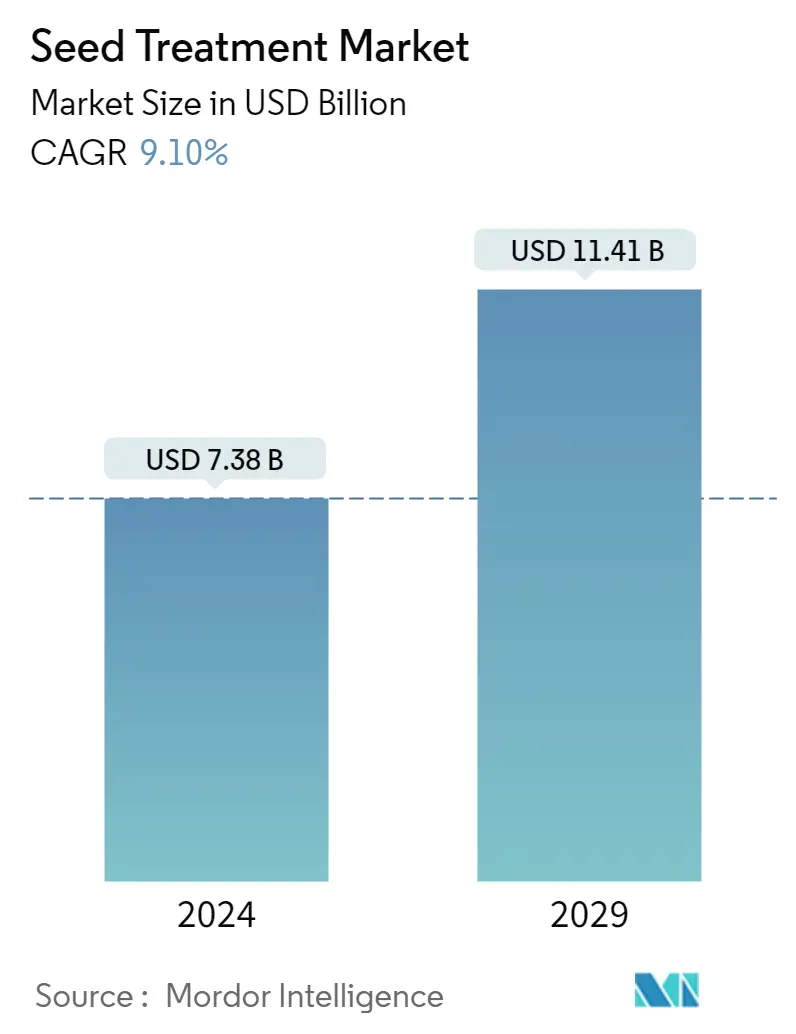
| Study Period | 2018 - 2028 |
| Market Size (2023) | USD 6.76 Billion |
| Market Size (2028) | USD 10.46 Billion |
| CAGR (2023 - 2028) | 9.10 % |
| Fastest Growing Market | Asia Pacific |
| Largest Market | Europe |
Major Players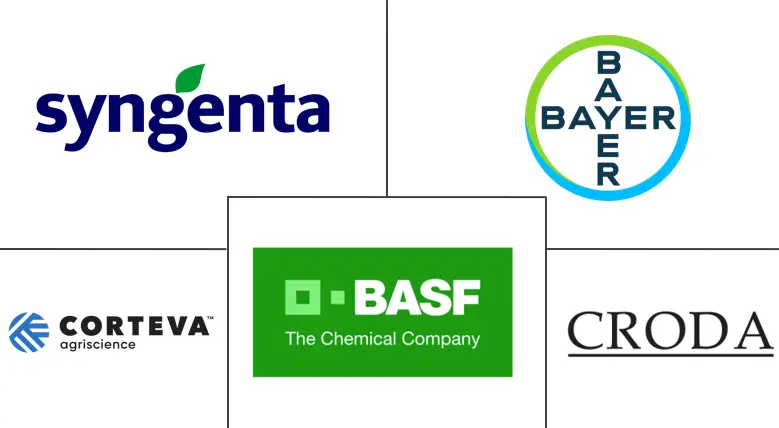
*Disclaimer: Major Players sorted in no particular order |
Need a report that reflects how COVID-19 has impacted this market and its growth?
Seed Treatment Market Analysis
The Seed Treatment Market size is estimated at USD 6.76 billion in 2023, and is expected to reach USD 10.46 billion by 2028, growing at a CAGR of 9.10% during the forecast period (2023-2028).
- Seed treatment plays an important role in protecting the seeds and seedlings from seed and soil-borne diseases and insect pests affecting crop emergence and growth. The advancement in seed treatment technology and rising government support with the increasing demand for high-quality seeds from the farmers is driving the market growth during the forecast period. Farmers are increasingly considering seed treatment as a mode to protect investments made on good quality seeds due to increased regulatory issues relating to fumigation and foliar application of pesticides. Hence, the rising awareness among farmers is fueling the sales of seed treatment chemicals across the globe.
- Additionally, as seed treatment is more effective and less labor-intensive than traditional spraying, it has become a more affordable crop protection method. Furthermore, to make seed treatment methods popular among farmers, various governments are organizing nationwide campaigns and promoting bills that will enable farmers to receive pesticides, herbicides, and fungicides at a subsidized price. Hence, increasing government support as well as the effectiveness of the seed treatment is likely to boost the growth of the seed treatment market in the coming years.
- Increasing awareness of environmental and health concerns among the people, the growing popularity of organic farming, the high demand for agricultural goods free of chemical residues, and the efforts made by governments around the world to encourage the use of biological seed treatment are some crucial factors contributing to the growth of the market.
Seed Treatment Market Trends
This section covers the major market trends shaping the Seed Treatment Market according to our research experts:
Increasing Popularity of High-quality Seeds
The increasing popularity associated with hybrids and genetically modified seeds is a significant factor driving the growth of the global seed treatment market. Farmers are increasingly considering seed treatment to protect investments made on good quality seeds due to increased regulatory issues relating to fumigation and foliar application of pesticides.
Owing to an increase in the demand for high-quality seeds with desirable agronomic traits, the cost of seeds is expected to increase. Both companies and farmers are ready to spend on seed treatment solutions to save high-quality seeds. For example, Syngenta conducted a trial program for VICTRATO, a pioneering seed treatment for the prevention of crown rot in wheat, durum, and barley. The formulation was improved for Australian circumstances with assistance from the Seedcare Institute (SCI), a worldwide network of Syngenta facilities. In May 2022, Syngenta Crop Protection’s Seedcare business launched VICTRATO, claiming it to be a novel technology with a powerful combination of nematode and disease control for growers looking to increase the quality and yield of their crops and support the long-term health of their soil.
Also, framers are trying to cut down operating costs by selecting seeds that do not require multiple doses of chemicals. The initial protection of these engineered seeds is ensured by using seed treatment products. In the past seven years, the seed’s portion of total operating costs for corn has increased from about 28% to 32%. As most GM seeds are more productive as they are treated with biological and chemical treatments, there is an increase in area under GM crops, which is expected to positively affect the seed treatment market growth.
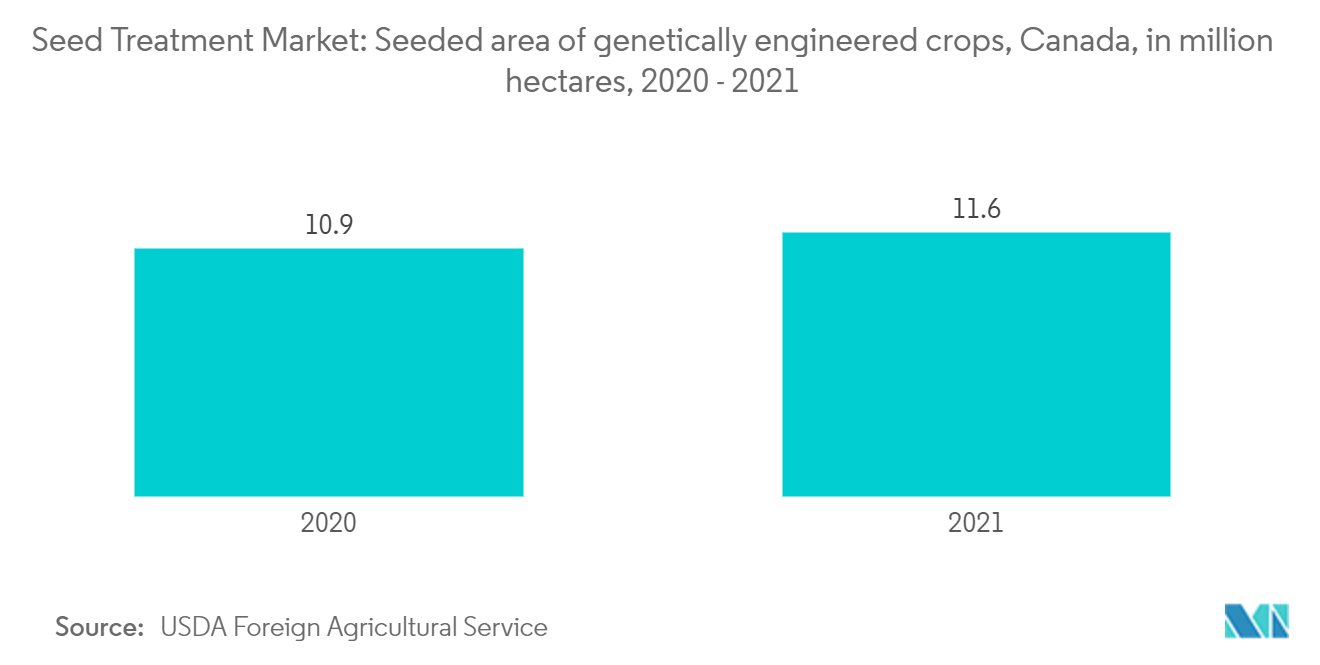
Europe Dominates the Seed Treatment Market
Europe witnessed the highest share in the seed treatment market, while Spain had the largest market for seed treatment, followed by France, Germany, and Russia. The growing popularity of agriculture in the region and the need for better-quality seeds are the major reasons for the market's growth. In significant crops, such as cereals (corn, barley, etc.) and fodder plants (alfalfa, clover, rapeseed, etc.), seed treatments are essential to prevent anthrax diseases, such as decay and bare smut. Moreover, seed treatments can also aid the early growth of the crop. Thus, the seed treatments based on manganese and zinc, which stimulate the plant's root system, are gaining popularity in the region.
In 2020, the sugar beet growers in Spain experienced crop damage and a decrease in yields by virus yellows. It created serious concerns among the farmers. They launched a plea to let them use Cruiser SB neonicotinoid treatment to reduce crop damage, which the government later approved. Thus, the increasing insect and pest attacks, the need of the growers to save the crop, and increasing yields are driving the market growth in the region.
According to a study, for every extra euro spent on this seed, relative to conventional seed, farmers gained an additional EUR 4.95 (USD 4.93) in extra income. These income gains have mostly come due to higher yields from the use of improved techniques, including seed treatments, which are influencing the growth of the market. In addition, the launch of seed treatment products by the major seed-producing companies in this region is aiding the growth of the seed treatment market. For instance, in 2021, KWS, a German seed-producing company, launched a biological seed treatment product in partnership with biotech company Evologic Technologies. Hence, the income gains obtained from the seed, along with the increased developments from the regional companies, contribute to the market's growth.
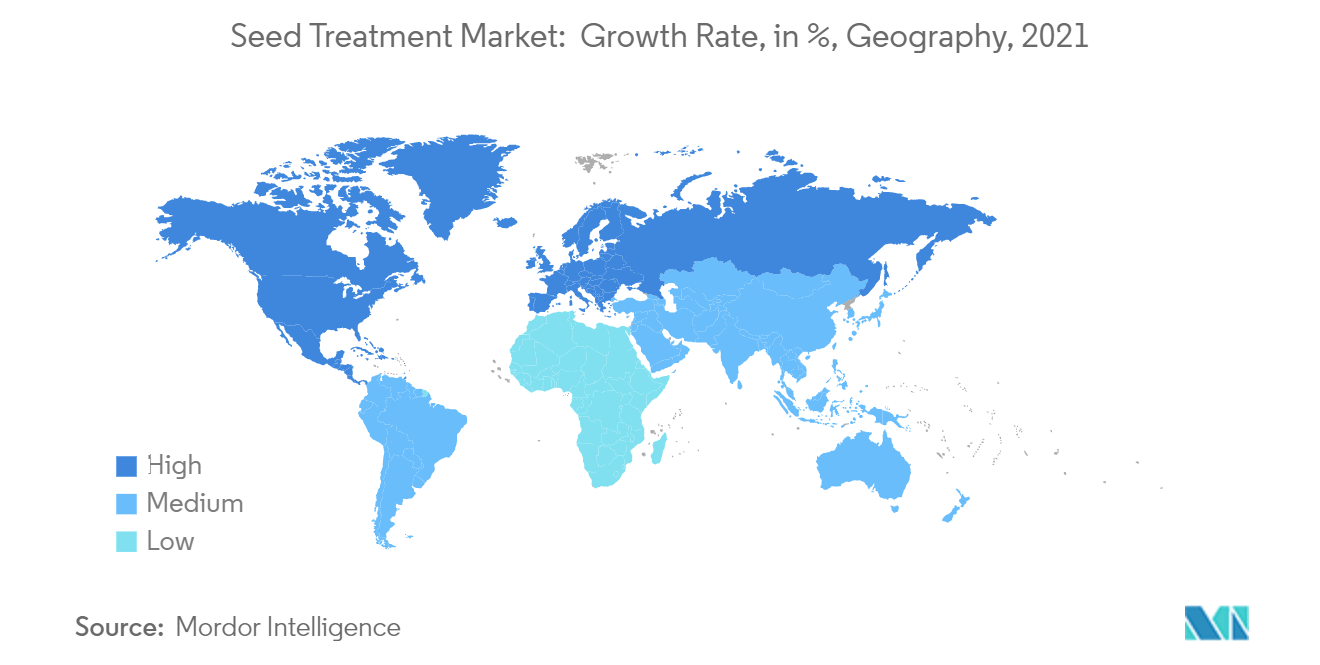
Seed Treatment Industry Overview
The seed treatment market is consolidated with several big players, such as Syngenta International AG, Bayer CropScience AG, BASF SE, Corteva Agriscience, and Croda International PLC. Major players in the market offer a diverse and increasing product portfolio. Companies are focusing majorly on new product launches and mergers & acquisitions, which help increase their market shares. The development of bio-based seed treatment products has massive potential for expansion during the forecast period, with several advantages, such as environmental sustainability and lesser regulations for developing and launching new products.
Seed Treatment Market Leaders
Syngenta International AG
Bayer CropScience AG
BASF SE
Corteva AgriScience
Croda International PLC
*Disclaimer: Major Players sorted in no particular order
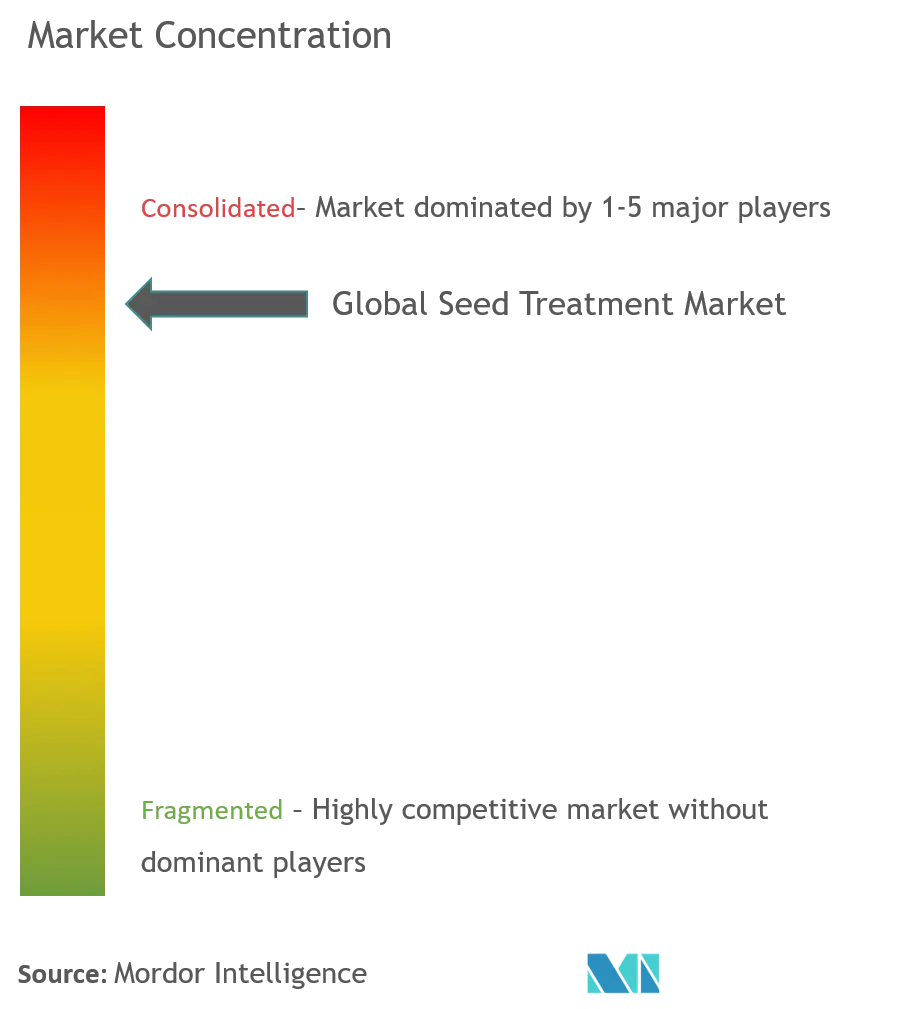
Seed Treatment Market News
July 2022: Corteva Agriscience launched two new seed treatment packages with multiple new products for corn and canola crops that will help growers with broad-spectrum of insect and disease control.
May 2022: Syngenta Seedcare launched, Victrato, a seed treatment product that targets nematodes and key soil-borne fungal diseases and increases the quality and yield of many crops, including soybeans, corn, cereals, cotton, and rice.
May 2022: Bayer launched Routine Start, a new seed treatment solution to safeguard early-season rice seeds from rice blast fungus and enhance crop productivity and resource effectiveness for rice farmers.
Seed Treatment Market Report - Table of Contents
1. INTRODUCTION
1.1 Study Assumptions & Market Definition
1.2 Scope Of The Study
2. RESEARCH METHODOLOGY
3. EXECUTIVE SUMMARY
4. MARKET DYNAMICS
4.1 Market Overview
4.2 Market Drivers
4.3 Market Restraints
4.4 Industry Attractiveness - Porter's Five Forces Analysis
4.4.1 Bargaining Power of Suppliers
4.4.2 Bargaining Power of Buyers
4.4.3 Threat of New Entrants
4.4.4 Threat of Substitute Products
4.4.5 Intensity of Competitive Rivalry
5. MARKET SEGMENTATION
5.1 By Application
5.1.1 Chemical
5.1.2 Non-chemical/Biological
5.2 By Function
5.2.1 Seed Protection
5.2.2 Seed Enhancement
5.2.3 Other Functions
5.3 By Crop Type
5.3.1 Grains and Cereals
5.3.2 Oilseeds
5.3.3 Vegetables
5.3.4 Other Crop Types
5.4 By Application Technique
5.4.1 Seed Coating
5.4.2 Seed Pelleting
5.4.3 Seed Dressing
5.4.4 Other Application Techniques
5.5 By Geography
5.5.1 North America
5.5.1.1 United States
5.5.1.2 Canada
5.5.1.3 Mexico
5.5.1.4 Rest of North America
5.5.2 Europe
5.5.2.1 Spain
5.5.2.2 United Kingdom
5.5.2.3 France
5.5.2.4 Germany
5.5.2.5 Russia
5.5.2.6 Italy
5.5.2.7 Rest of Europe
5.5.3 Asia-Pacific
5.5.3.1 China
5.5.3.2 Japan
5.5.3.3 India
5.5.3.4 Australia
5.5.3.5 Rest of Asia-Pacific
5.5.4 South America
5.5.4.1 Brazil
5.5.4.2 Argentina
5.5.4.3 Rest of South America
5.5.5 Africa
5.5.5.1 South Africa
5.5.5.2 Rest of Africa
6. COMPETITIVE LANDSCAPE
6.1 Most Adopted Strategies
6.2 Market Share Analysis
6.3 Company Profiles
6.3.1 Adama Agricultural Solutions Ltd
6.3.2 Advanced Biological Marketing Inc.
6.3.3 BASF SE
6.3.4 Bayer Cropscience AG
6.3.5 Bioworks Inc.
6.3.6 Corteva Agriscience
6.3.7 Germains Seed Technology
6.3.8 Croda International PLC (Incotec Group BV)
6.3.9 Nufarm Ltd
6.3.10 Plant Health Care
6.3.11 Precision Laboratories Inc.
6.3.12 Syngenta International AG
6.3.13 Valent Biosciences Corporation
6.3.14 Verdesian Life Sciences
7. MARKET OPPORTUNITIES AND FUTURE TRENDS
Seed Treatment Industry Segmentation
Seed treatment products are biological, physical, and chemical agents and techniques applied to seeds in order to protect and improve the establishment of healthy crops.
The Seed Treatment Market is Segmented by Application (Chemical and Non-chemical/Biological), Function (Seed Protection, Seed Enhancements, and Other Functions), Crop Type (Grains and Cereals, Oilseeds, Vegetables, and Other Crop Types), Application Technique (Seed Coating, Seed Pelleting, Seed Dressing, and Other Application Techniques), and Geography (North America, Europe, Asia-Pacific, South America, and Africa). The report offers market size and forecasts in value (USD million) for all the above segments.
| By Application | |
| Chemical | |
| Non-chemical/Biological |
| By Function | |
| Seed Protection | |
| Seed Enhancement | |
| Other Functions |
| By Crop Type | |
| Grains and Cereals | |
| Oilseeds | |
| Vegetables | |
| Other Crop Types |
| By Application Technique | |
| Seed Coating | |
| Seed Pelleting | |
| Seed Dressing | |
| Other Application Techniques |
| By Geography | |||||||||
| |||||||||
| |||||||||
| |||||||||
| |||||||||
|
Seed Treatment Market Research FAQs
How big is the Seed Treatment Market?
The Seed Treatment Market size is expected to reach USD 6.76 billion in 2023 and grow at a CAGR of 9.10% to reach USD 10.46 billion by 2028.
What is the current Seed Treatment Market size?
In 2023, the Seed Treatment Market size is expected to reach USD 6.76 billion.
Who are the key players in Seed Treatment Market?
Syngenta International AG, Bayer CropScience AG, BASF SE, Corteva AgriScience and Croda International PLC are the major companies operating in the Seed Treatment Market.
Which is the fastest growing region in Seed Treatment Market?
Asia Pacific is estimated to grow at the highest CAGR over the forecast period (2023-2028).
Which region has the biggest share in Seed Treatment Market?
In 2023, the Europe accounts for the largest market share in the Seed Treatment Market.
Seed Treatment Industry Report
Statistics for the 2023 Seed Treatment market share, size and revenue growth rate, created by Mordor Intelligence™ Industry Reports. Seed Treatment analysis includes a market forecast outlook to 2028 and historical overview. Get a sample of this industry analysis as a free report PDF download.
